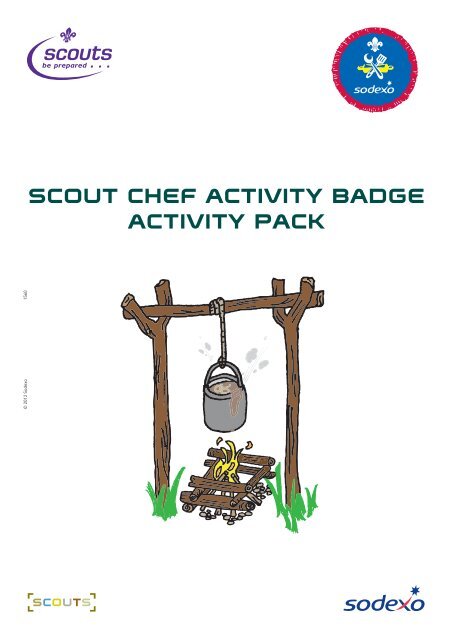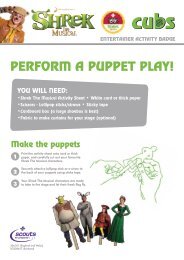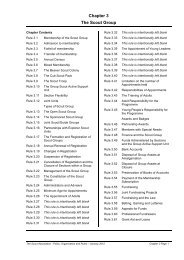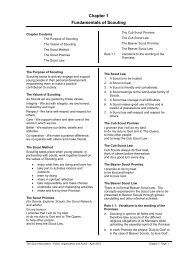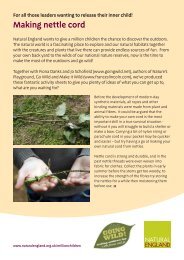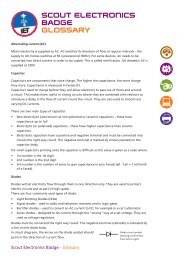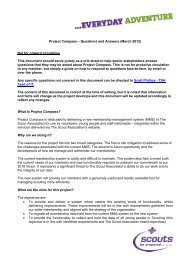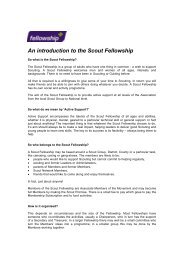SCOUT CHEF ACTIVITY BADGE ACTIVITY PACK
SCOUT CHEF ACTIVITY BADGE ACTIVITY PACK
SCOUT CHEF ACTIVITY BADGE ACTIVITY PACK
- No tags were found...
You also want an ePaper? Increase the reach of your titles
YUMPU automatically turns print PDFs into web optimized ePapers that Google loves.
© 2012 Sodexo 1560<strong>SCOUT</strong> <strong>CHEF</strong> <strong>ACTIVITY</strong> <strong>BADGE</strong><strong>ACTIVITY</strong> <strong>PACK</strong>
WELCOME TO THE <strong>SCOUT</strong> <strong>CHEF</strong> <strong>ACTIVITY</strong> <strong>BADGE</strong><strong>ACTIVITY</strong> <strong>PACK</strong>, YOUR LEADER WILL HELP YOUGET STARTEDYOUR <strong>ACTIVITY</strong> <strong>PACK</strong> INCLUDES:• hand-washing poster• fridge storage• foods to be cut out for fridge storage activity• cooking methods game• cooking methods• spot the hazards• buying and transporting food• eatwell plate• food diary-breakfast• food diary-lunch• food diary-dinnerPAGE:34567131417181920© 2012 Sodexo 1560
PREPARING OR SERVING FOOD?HOW TO WASH HANDS:FOOD SAFETY• always use a hand wash basin, nota food preparation sink• always use warm water, wet handsbefore applying antibacterial soap• wash hands palm to palm (A)• lock fingers and wash (B)• wash hands front to back (C)• wash hands fist to palm (D)• wash thumbs (E)• wash finger to palm (F)• wash wrists (G)• rinse with clean running water• germs spread more easily if handsare wet, so dry them thoroughly using apaper towelMAKE SURE THAT:© 2012 Sodexo 1560• you wash your hands frequently• you avoid unhygienic habits• you keep fingernails short and clean• nail varnish and false nails are off• you do not wear jewellery
FOOD SAFETYFridge food storage Activity Page 1 of 2© 2012 Sodexo 1560
FOOD SAFETYFridge food storage Activity Page 2 of 2Cut out along the dotted lines and place the items on the correctshelf in the fridge
<strong>CHEF</strong><strong>ACTIVITY</strong><strong>BADGE</strong>Scouts cook!FOOD PREPARATIONCan you match each differentway of cooking on the left withsomething on the right…?1. Cooking in water2. Boiling3. Poaching4. Steaming5. Microwaving6. Grilling7. Frying8. Deep-frying9. Braising10. Stewing11. Roasting12. BakingA. Be very careful with the hot oil!B. The camp fire is the most fun forthis one!C. Gentle heat and a thick bottomed pot.D. No need for oil, juicy meat will dothe job.E. Batter or breadcrumb coating.F. Enjoy delicious eggs!G. Delicious bread and cakes.H. 100°C is the temperature ‘point’ here.I. Don’t forget the lid on the pot inthe oven.J. The energy makes water moleculesgo crazy!K. Great for potatoes, pasta and rice!L. The best way to keep vitamins andnutrients locked in!Answers: 1k, 2h, 3f, 4l, 5j, 6d, 7a, 8e, 9i, 10c, 11b, 12g
<strong>CHEF</strong><strong>ACTIVITY</strong><strong>BADGE</strong>Scouts Cook!<strong>CHEF</strong><strong>ACTIVITY</strong><strong>BADGE</strong>Scouts Cook!COOKING IN WATER© 2012 Sodexo 1560Boiling, steaming, poaching, microwaving, roasting,grilling, frying, stewing, braising, baking…There are many different ways of cooking to explore andenjoy with different effects on look, taste and nutrition.These cards will help you understand what’s what. In yourPatrol or in twos or threes, read the Scouts Cook! cardsand tick the boxes at the bottom of each card to say ifeach way of cooking is slow or fast, good for nutrientsand vitamins or fatty, involves hot water or hot oil.How?You can cook food in water and bring it to the boil or start to cookonce your water has reached boiling point.What happens to the food?If you cook food in water, you have to keep an eye on the clock:cook it too long and you’ll lose the flavours, colours and texture…The longer you cook food in water, the more vitamins and othernutrients are lost too.Cooking in water is great for potatoes, pasta and rice, vegetablesand some meats too.TICK EACH BOX THAT MATCHES THIS WAY OF COOKING
<strong>CHEF</strong><strong>ACTIVITY</strong><strong>BADGE</strong>Scouts Cook!© 2012 Sodexo 1560<strong>CHEF</strong><strong>ACTIVITY</strong><strong>BADGE</strong>Scouts Cook!© 2012 Sodexo 1560BOILING ANDPOACHING FOODS.STEAMINGHow?Water boils at 100°C, you can reduce the temperature away fromboiling point for a more gentle, slower cook.Poaching is great for foods that are more delicate and those likely tobreak up if cooked too rapidly in boiling water.Poached eggs are delicious: bring the water with a pinch of salt and2-3 drops of vinegar to just under the boil - a few bubbles should bebreaking the surface - give the water a quick swirl with a spoon, breakthe egg into the pan and cook gently for 2-3 minutes.How?The easiest way to steam is to pour a small amount of water into apan, wait until the water boils and then put your food in a steamingbasket and into the pan.What happens to the food?Believe it or not, steaming is the best way to make sure your foodkeeps its flavour, vitamins and other nutrients!Steaming is great for green vegetables, fresh fish or chicken. Try alittle wedge of lemon or lime in the water for a flavoured twist.Watch out! Boiling water and steam have to be treated with a lot ofcare to make sure that you don’t burn yourself or someone else!Watch out! Boiling water and steam have to be treated with a lotof care to make sure that you don’t burn yourself or someone else!TICK EACH BOX THAT MATCHES THIS WAY OF COOKINGTICK EACH BOX THAT MATCHES THIS WAY OF COOKING
<strong>CHEF</strong><strong>ACTIVITY</strong><strong>BADGE</strong>Scouts Cook!© 2012 Sodexo 1560<strong>CHEF</strong><strong>ACTIVITY</strong><strong>BADGE</strong>Scouts Cook!© 2012 Sodexo 1560MICROWAVINGGRILLINGHow?Very popular for cooking and reheating a wide variety of foods andready meals. Always check the manufacturer’s advice which variesfrom product to product.What happens to the food?Microwaves are a form of energy that agitates water molecules andcauses friction that turns into heat. Microwaving is fast, so ideal forquick meals.Watch out! You should never put metal into a microwave or oil asit can burn! Microwave cooking heats the food from the inside out,so be careful: the outside might seem cool but the centre may beextremely hot.How?Grilling is usually done under a grill, or on a chargrill, over a barbecueor, even better for Scouts, a camp fire!What happens to the food?Unlike frying, if you grill meats such as sausages or a steak, youdon’t need oil as the meat’s natural juices do the job. Some foodsmay need a little oil (fish or vegetables and some meats) but youuse less than in frying.Eating a lot of grilled food is not very good for our health, just oncein a while is fine.Watch out!It’s easy to burn food when you’re grilling it…TICK EACH BOX THAT MATCHES THIS WAY OF COOKINGTICK EACH BOX THAT MATCHES THIS WAY OF COOKING
<strong>CHEF</strong><strong>ACTIVITY</strong><strong>BADGE</strong>Scouts Cook!© 2012 Sodexo 1560<strong>CHEF</strong><strong>ACTIVITY</strong><strong>BADGE</strong>Scouts Cook!© 2012 Sodexo 1560FRYING (ALSO KNOWN AS SHALLOW FRYING)DEEP FRYINGHow?Frying is usually done in a frying pan in hot oil.How?Cooking food completely covered in hot fat.What happens to the food?Certain foods react well to frying. However, be aware that friedfoods can be harmful to our health due to added oil so rememberto use other ways of cooking food regularly.Watch out!Hot oil gets very, very hot and can even catch fire! Only fry with anadult close by.TICK EACH BOX THAT MATCHES THIS WAY OF COOKINGWhat happens to the food?Foods for deep frying are usually coated in batter or breadcrumbsand may include fish, meat, vegetables and even fruit. Eating a lotof deep fried food is not good for our health so remember to useother ways of cooking food regularly.Watch out!Only fry with an adult close by. Never use a pan of oil: use anelectric fryer with proper safety features.TICK EACH BOX THAT MATCHES THIS WAY OF COOKING
<strong>CHEF</strong><strong>ACTIVITY</strong><strong>BADGE</strong>Scouts Cook!© 2012 Sodexo 1560<strong>CHEF</strong><strong>ACTIVITY</strong><strong>BADGE</strong>Scouts Cook!© 2012 Sodexo 1560STEWINGBRAISINGHow?Cooking small pieces of meat or vegetables slowly in liquid – likestock - until tender.How?Similar to stewing but using larger pieces of meat, half coveredwith liquid and cooked in the oven.What happens to the food?Stewed meat stays tender and the liquid you stew it in brings a lotof flavour.Watch out!Make sure you check frequently and add liquid as needed. Alwayscover the casserole dish with a lid.Watch Out!Don’t forget to keep the heat at a gentle level and use a thickbottomed pot or casserole dish to avoid burning the food.TICK EACH BOX THAT MATCHES THIS WAY OF COOKINGTICK EACH BOX THAT MATCHES THIS WAY OF COOKING
<strong>CHEF</strong><strong>ACTIVITY</strong><strong>BADGE</strong>Scouts Cook!© 2012 Sodexo 1560<strong>CHEF</strong><strong>ACTIVITY</strong><strong>BADGE</strong>Scouts Cook!© 2012 Sodexo 1560ROASTINGBAKINGHow?In the oven or over the camp fire! You can use herbs, marinadesand spices to vary flavours.What happens to the food?Roasting is popular because it gives a tasty, crunchy skin and meatjuices get locked in. Roasting keeps the nutrients in and ideal forgood quality meat joints and fish. Roast vegetables are deliciousespecially with a little seasoning and drizzle of olive oil.How?Cooking food with a dry heat in the oven.What happens to the food?Due to the dry heat involved, bread, cakes, biscuits and pastry itemsas well as meats and fish work well when baked.Watch out!Dry heat can really ‘dry out’ the food so take care not to overcook.Watch out! Roasting meats too fast or for too long will make thefood dry and chewy.TICK EACH BOX THAT MATCHES THIS WAY OF COOKINGTICK EACH BOX THAT MATCHES THIS WAY OF COOKING
© 2012 Sodexo 1560FOOD HAZARDS*Answers: 1.Mop bucket beside the fridge 2. Toaster wire in the filled sink 3. Knife on the counter edge 4. Water on the floor 5. Bleach oncounter top beside cheese 6. Microwave wire hanging down 7. Cupboard door open 8. Open bottle on counter 9. Banana skin on the floor10. Cheese not in the fridge
Page 1 of 3<strong>SCOUT</strong>S OUT AND ABOUT:BUYING AND TRANSPORTING FOODAlways start with the key questions for cooking: plan your menu withreference to the Scout Chef Activity Badge planning resources.“What are you going to cook?” is one of the key questions as all goodcooking requires planning. Try some of the amazing recipes included inthe Scout Chef Activity Badge resources. That said, don’t forget that thereare many places to find a recipe other than in cookery books: ask friendsand family, try a website like www.bbcgoodfood.com or type a recipeidea into an online search engine and see what happens!There are also many smartphone apps and Facebook pages with fantastic recipes: try the ‘epicurious’app and try following Great British Chefs or The Staff Canteen on Facebook for some great ideas.‘The devil’s in the detail’!When you have found a recipe you like, make sure you read it all the way through: there’s nothing more irritating thanrealising half way through that you cannot finish it because you do not have the right piece of equipment or ingredient…When you have read the recipe and decided you want to try it, think about how it will look when you have done it: doyou want to change any of the ingredients? If so, what will that do to the recipe? Will it alter the balance of flavour, theappearance, the taste? When you think about these points, also think what you will serve the dish with: make sure to writedown your ideas on your shopping list with the ingredients in the recipe.© Sodexo 20121560So, now you know what to buy: can you afford it?Unless you were looking at recipes with lobster or fillet steak, you should be able to make good food much cheaper thanbuying a ready meal! Many recipes online or in apps will have an indicator of cost in the method. If not, and you want toknow roughly how much it will cost, visit a supermarket website and type in the ingredient and the amount to work outthe cost.Where do you buy your food?Remember there are many outlets in your area just waiting to exchange your money for their food!Supermarkets can be useful as you will be able to get all of your ingredients under one roof, it will all be displayed nicelyand look appetising. However, remember there’s a lot more to the experience of choosing and buying food thana supermarket!Local greengrocers are also great for buying your fruit and vegetables, learning what’s in seasonand where it’s from.
Page 2 of 3<strong>SCOUT</strong>S OUT AND ABOUT:BUYING AND TRANSPORTING FOODRemember: the fresher the fruit and vegetables, the more flavour they have!Local butchers are also great places to shop: they also often stock local produce and may evenbe able to tell you the name of the farmer who produced the meat. Your local butcher canrecommend different cuts of meat with great knowledge ready to be shared.Local fishmongers or a visiting fishmonger are a great way to access fish and shellfish as oftenthey are supplied daily from the local port and their fish can be 2-3 days fresher than elsewhere.Again, your fishmonger is likely to have a wealth of knowledge about the products served andwill prepare what you want to your exact requirements.Local around you: don’t forget there are probably many local suppliers right under yournose: local eggs or crops from allotments may be worth seeking out too!Best of all and really fun, you can always grow your own! Nothing is nicer than pickingyour own salad leaves, herbs or fruit and vegetables straight from the garden.Transporting your food is relatively simple if you think about a few points.The things that need to be transported quickest to slowest are:• Frozen foods• Fresh meats, fish and dairy products• Other chilled products• Fresh fruit and vegetables• Dry goods (nuts, tinned goods, biscuits etc.)Remembering this will make it much easier for you to shop. Start at the bottom of the list and work your way up: buy thedry goods first and finish with the fresh meat, fish and frozen products.Buying• Store all frozen products in the same padded freezer bag (available from supermarkets and specialist shops) or acool box if possible. This helps to keep them all frozen longer. If using a car, put them in the boot, out of the sunand get them into a freezer as soon as possible.• Be careful packing fruit and vegetables: they can be fragile and / or bruise• Pack heavy items like potatoes at the bottom of the bag and soft things like strawberries on the top© Sodexo 20121560• Try to keep all meat and fish in separate bags from fruit, veg and dairy products to avoid getting blood or otheritems on raw food• Always wash your hands after handling raw meat or fishNow that you have decided what to cook, decided you can afford it and written a shopping list,bought the food and got it home, it’s time to cook it! Read that recipe again, and once more...!Enjoy cooking!
Page 3 of 3<strong>SCOUT</strong>S OUT AND ABOUT:BUYING AND TRANSPORTING FOODNow you know a bit more about buying and transporting food, try this quick ‘true or false’1. Foods that need to be transported quickest to slowest are: fresh meats, fresh fruit andvegetables, fresh fish. [True / False] (tick your answer)TrueFalse2. You should always pack heavy / less fragile foods at the bottom of your shopping bag.TrueFalse3. Fresh meat or fish can be packed in the same bag as bananas.TrueFalse4. Fish at a local fishmonger can be 2 to 3 weeks fresher than elsewhere.TrueFalse5. You only need to wash your hands before handling meat or fish.TrueFalse6. Fillet steak and lobster are good value every day ingredients.TrueFalse7. It’s possible to check how much your shopping list might cost before you go shopping.TrueFalse© Sodexo 20128. Vegetables, fruit, salad leaves and herbs are all foods that you can grow in season.TrueFalse1560Answers: 1 false, 2 true, 3 false, 4 false, 5 false, 6 false, 7 true, 8 true.
HEALTH ANDNUTRITIONBread, rice, potatoes, pasta and other starchy foodsFruit and vegetablesNon-dairy sources of proteinFoods and drinks high in fat and/or sugarMilk and dairy foods1560© Sodexo 2012Cut out your plate using the dotted line guideFill your Eatwell plate!Now you’ve learned about the Eatwell plate and the different food groups that make upa healthy, balanced diet, it’s over to you!Cut out your Eatwell plate and fill it with the foods that you would like in your perfectmeal. Draw each food into the right slice to illustrate your design! Or, if you prefer, youcould cut out foods from magazines and stick them in.
HEALTH ANDNUTRITIONBread, rice, potatoes, pasta and other starchy foodsFruit and vegetablesBreakfastNon-dairy sources of proteinMilk and dairy foodsFoods and drinks high in fat and/or sugarCut out your plate using the dotted line guideThe Eatwell plate one-day food diary!© Sodexo 2012Now you’ve learned about the Eatwell plate and the different foodgroups that make up a healthy, balanced diet, why not see how wellyou do?Cut out your Eatwell plate and fill it with the foods and liquids that youhave during one whole day from when you wake up to when you goto sleep.Once you’ve filled your Eatwell plate one-day food diary, get togetherwith your Scout Pack to see how well you think you did.1560Did you manage to have a healthy balanced diet? What foods or liquidscould you have had more or less of? Why?
HEALTH ANDNUTRITIONBread, rice, potatoes, pasta and other starchy foodsFruit and vegetablesLunchNon-dairy sources of proteinMilk and dairy foodsFoods and drinks high in fat and/or sugarCut out your plate using the dotted line guideThe Eatwell plate one-day food diary!© Sodexo 2012Now you’ve learned about the Eatwell plate and the different foodgroups that make up a healthy, balanced diet, why not see how wellyou do?Cut out your Eatwell plate and fill it with the foods and liquids that youhave during one whole day from when you wake up to when you goto sleep.Once you’ve filled your Eatwell plate one-day food diary, get togetherwith your Scout Pack to see how well you think you did.1560Did you manage to have a healthy balanced diet? What foods or liquidscould you have had more or less of? Why?
HEALTH ANDNUTRITIONBread, rice, potatoes, pasta and other starchy foodsFruit and vegetablesDinnerNon-dairy sources of proteinMilk and dairy foodsFoods and drinks high in fat and/or sugarCut out your plate using the dotted line guideThe Eatwell plate one-day food diary!© Sodexo 2012Now you’ve learned about the Eatwell plate and the different foodgroups that make up a healthy, balanced diet, why not see how wellyou do?Cut out your Eatwell plate and fill it with the foods and liquids that youhave during one whole day from when you wake up to when you goto sleep.Once you’ve filled your Eatwell plate one-day food diary, get togetherwith your Scout Pack to see how well you think you did.1560Did you manage to have a healthy balanced diet? What foods or liquidscould you have had more or less of? Why?


